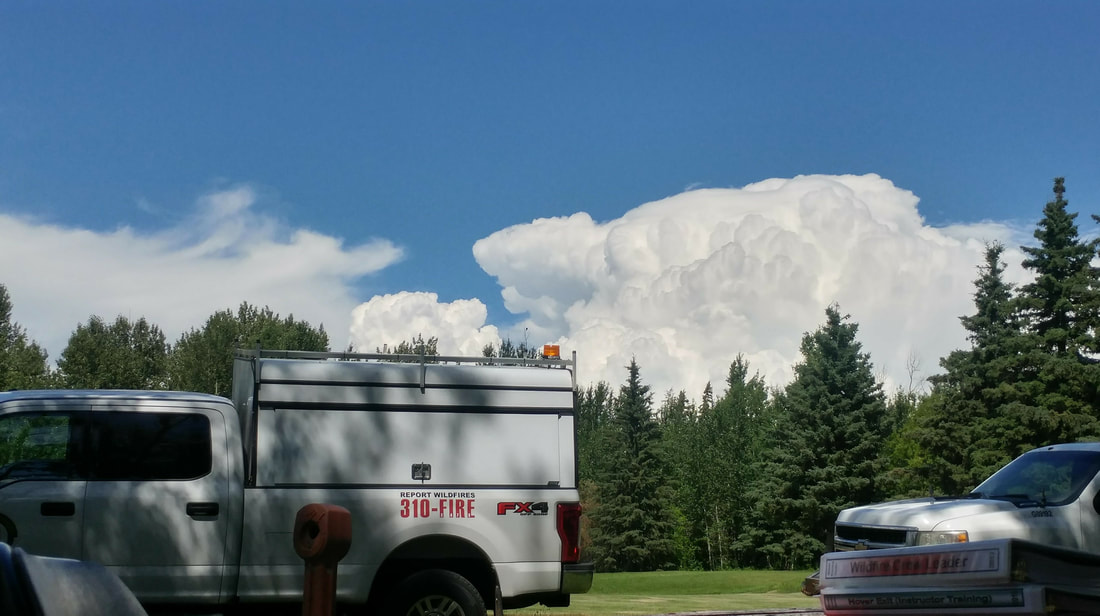Instantly, the crew jumps into action as adrenaline begins to surge. We are loaded into the helicopter and taking off in a few short minutes. Radio-chatter fills the headsets in the helicopter as the pilot, crew leader and dispatchers communicate crucial information on details of the fire. Looking out the window of the machine, I see the smoke from a distance. It’s faint and as we get closer it becomes clear this fire is going to be a classic “one-tree-wonder” (a name given when lightning ignites a tree and the ground directly beneath it but remains small and easily suppressed).
We get to the fire and circle overhead in the air. More radio chatter as the crew lead relays information to dispatch about the fire behaviour, fuel type, rate of spread and presence or absence of any values at risk. When the quick assessment is complete, we circle slightly higher, looking for an adequate place to land… black spruce trees blanket the landscape and our search broadens... Luckily, the fire is not spreading too quickly as we have to land farther away than we would like. The helicopter lowers and maintains a hover over the “ground” allowing us to exit and unload our gear right into the swampy muskeg mess. Immediately, water pools above my knees and as I stumble through the uneven wet ground, I seem to find deeper and deeper holes to fall into. First things first, we need to improve our landing spot to ensure a safe pickup area for when the helicopter returns. I watch a senior crew member fall trees while up to his waist in water and when it is safe, I clumsily manoeuvre and wade my way over to move some of the trees out of the way and place some into the center of our pool for the helicopter skids to rest on for our eventual pickup from the bush. When we start our slog towards the fire, we move both quickly and slowly at the same time. Our efforts towards a quick pace become dulled in the deep muskeg as each step forward turns into a step deeper and deeper into the watery depths of the earth. After what feels like an eternity of sinking, falling and stumbling on, our noses guide us toward the smoke of our fire. Luckily, it is still small, and our crew makes quick work of extinguishing it. After a thorough assessment of the area and when we are certain it is completely out, we turn around and start the journey back out through the muskeg. The weather is hot and muggy, and the bog bugs are in full force after being disturbed by our hike in. Our pilot is called back to meet us at the landing pad. Being the experienced pilot that they are, they spot us hiking out and fly in low behind us while using the downwash from the rotors to cool us off and blast the bugs out of our way. It is greatly appreciated by all of us and we pay the pilot back by climbing in, soaking wet, and getting mud everywhere in their machine. Then, it’s up in the air and off to put out another fire nearby that started from the same lightning storm! Stay tuned for Part 2: The “High”, when our Firefighter in the field tackles flames in the mountains of Southern British Columbia.
1 Comment
2/25/2019 05:53:32 pm
Nice story Kate. Well done. I remember when I got dropped off in my first AB swamp back in 1981 (up to my waist).
Reply
Leave a Reply. |
FIELD NOTESOur research at the University of Alberta often involves stints in the field. Field Notes posted here are written by team members and report on their adventures off-campus. Archives
December 2024
|
© 2025 by J. Beverly
Banner photo courtesy Alberta Wildfire - Fire PWF-034 2018
Banner photo courtesy Alberta Wildfire - Fire PWF-034 2018



 RSS Feed
RSS Feed